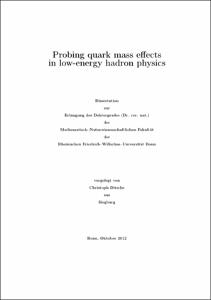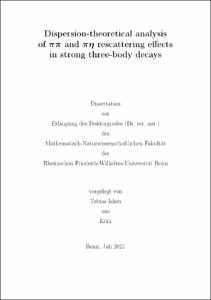Nißler, Robin: Topics in three flavor chiral dynamics. - Bonn, 2008. - Dissertation, Rheinische Friedrich-Wilhelms-Universität Bonn.
Online-Ausgabe in bonndoc: https://nbn-resolving.org/urn:nbn:de:hbz:5N-13163
Online-Ausgabe in bonndoc: https://nbn-resolving.org/urn:nbn:de:hbz:5N-13163
@phdthesis{handle:20.500.11811/3571,
urn: https://nbn-resolving.org/urn:nbn:de:hbz:5N-13163,
author = {{Robin Nißler}},
title = {Topics in three flavor chiral dynamics},
school = {Rheinische Friedrich-Wilhelms-Universität Bonn},
year = 2008,
note = {In this work, we investigate several processes in low-energy hadron physics by combining chiral perturbation theory (ChPT), the effective field theory of quantum chromodynamics (QCD) at low energies, with a unitarization method based on the Bethe-Salpeter equation. Such so-called chiral unitary approaches are capable of describing processes in the three flavor sector of the strong interaction which involve substantial effects from final-state interactions and the excitation of (subthreshold) resonances, a domain where the perturbative framework of ChPT is not applicable.In part I of this work we study η and η' decays which constitute a perfect tool to examine symmetries and symmetry breaking patterns of QCD being incorporated in a model-independent fashion in ChPT. In particular, these decays allow to investigate the breaking of isospin symmetry due to the light quark mass difference md - mu as well as effects of anomalies stemming from the quantum nature of QCD. For these reasons the decays of η and η' have also attracted considerable experimental interest. They are currently under investigation at several facilities including KLOE@DAFNE, Crystal Ball at MAMI, WASA-at-COSY, VES at IHEP, and CLEO at CESR.
In part II we investigate low-energy meson-baryon scattering in the strangeness S = -1 sector which is dominated by the Λ(1405) resonance immediately below the KN threshold. The KN interaction below threshold is of relevance for the quest of possible deeply bound K-nuclear clusters and has recently received an additional tight constraint: the K-p scattering length as determined from kaonic hydrogen by the KEK and the DEAR collaborations.
Apart from successfully describing a large amount of experimental data and furnishing predictions for yet unmeasured quantities, our calculations allow to interrelate different experimental observables providing important consistency tests of experiments. E.g. the DEAR results are shown to be inconsistent with previous K-p scattering data and we demonstrate that the Dalitz plot parameters of the two decay modes η -> 3 p0, η -> p+ p- p0 as determined in the (first) analysis of the KLOE Collaboration are not compatible. In fact, they violate an important isospin rule. By performing a large number of fits to experimental data with randomized starting points we are furthermore able to give for the first time in chiral unitary approaches error estimates for our results and predictions.},
url = {https://hdl.handle.net/20.500.11811/3571}
}
urn: https://nbn-resolving.org/urn:nbn:de:hbz:5N-13163,
author = {{Robin Nißler}},
title = {Topics in three flavor chiral dynamics},
school = {Rheinische Friedrich-Wilhelms-Universität Bonn},
year = 2008,
note = {In this work, we investigate several processes in low-energy hadron physics by combining chiral perturbation theory (ChPT), the effective field theory of quantum chromodynamics (QCD) at low energies, with a unitarization method based on the Bethe-Salpeter equation. Such so-called chiral unitary approaches are capable of describing processes in the three flavor sector of the strong interaction which involve substantial effects from final-state interactions and the excitation of (subthreshold) resonances, a domain where the perturbative framework of ChPT is not applicable.In part I of this work we study η and η' decays which constitute a perfect tool to examine symmetries and symmetry breaking patterns of QCD being incorporated in a model-independent fashion in ChPT. In particular, these decays allow to investigate the breaking of isospin symmetry due to the light quark mass difference md - mu as well as effects of anomalies stemming from the quantum nature of QCD. For these reasons the decays of η and η' have also attracted considerable experimental interest. They are currently under investigation at several facilities including KLOE@DAFNE, Crystal Ball at MAMI, WASA-at-COSY, VES at IHEP, and CLEO at CESR.
In part II we investigate low-energy meson-baryon scattering in the strangeness S = -1 sector which is dominated by the Λ(1405) resonance immediately below the KN threshold. The KN interaction below threshold is of relevance for the quest of possible deeply bound K-nuclear clusters and has recently received an additional tight constraint: the K-p scattering length as determined from kaonic hydrogen by the KEK and the DEAR collaborations.
Apart from successfully describing a large amount of experimental data and furnishing predictions for yet unmeasured quantities, our calculations allow to interrelate different experimental observables providing important consistency tests of experiments. E.g. the DEAR results are shown to be inconsistent with previous K-p scattering data and we demonstrate that the Dalitz plot parameters of the two decay modes η -> 3 p0, η -> p+ p- p0 as determined in the (first) analysis of the KLOE Collaboration are not compatible. In fact, they violate an important isospin rule. By performing a large number of fits to experimental data with randomized starting points we are furthermore able to give for the first time in chiral unitary approaches error estimates for our results and predictions.},
url = {https://hdl.handle.net/20.500.11811/3571}
}









